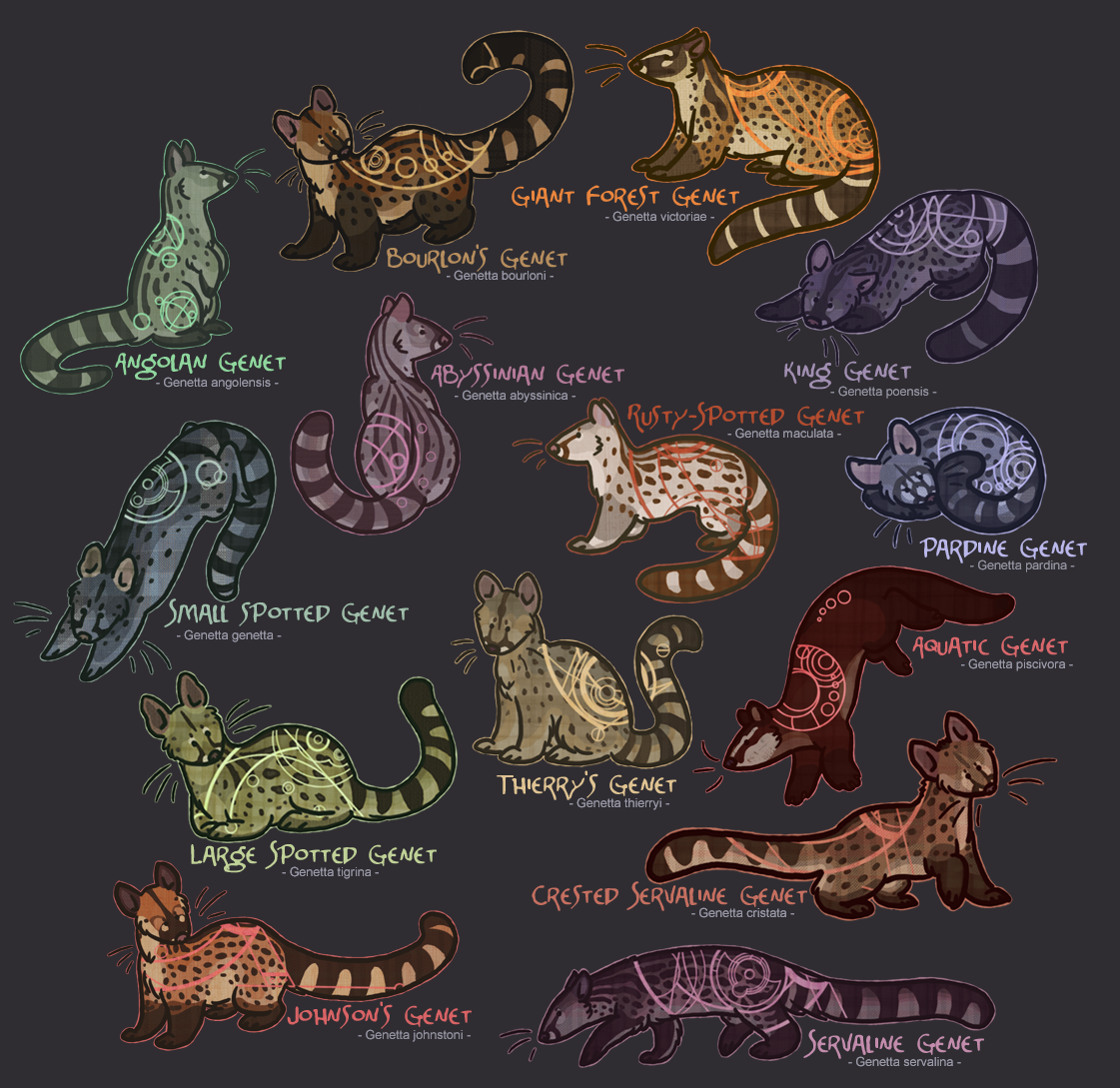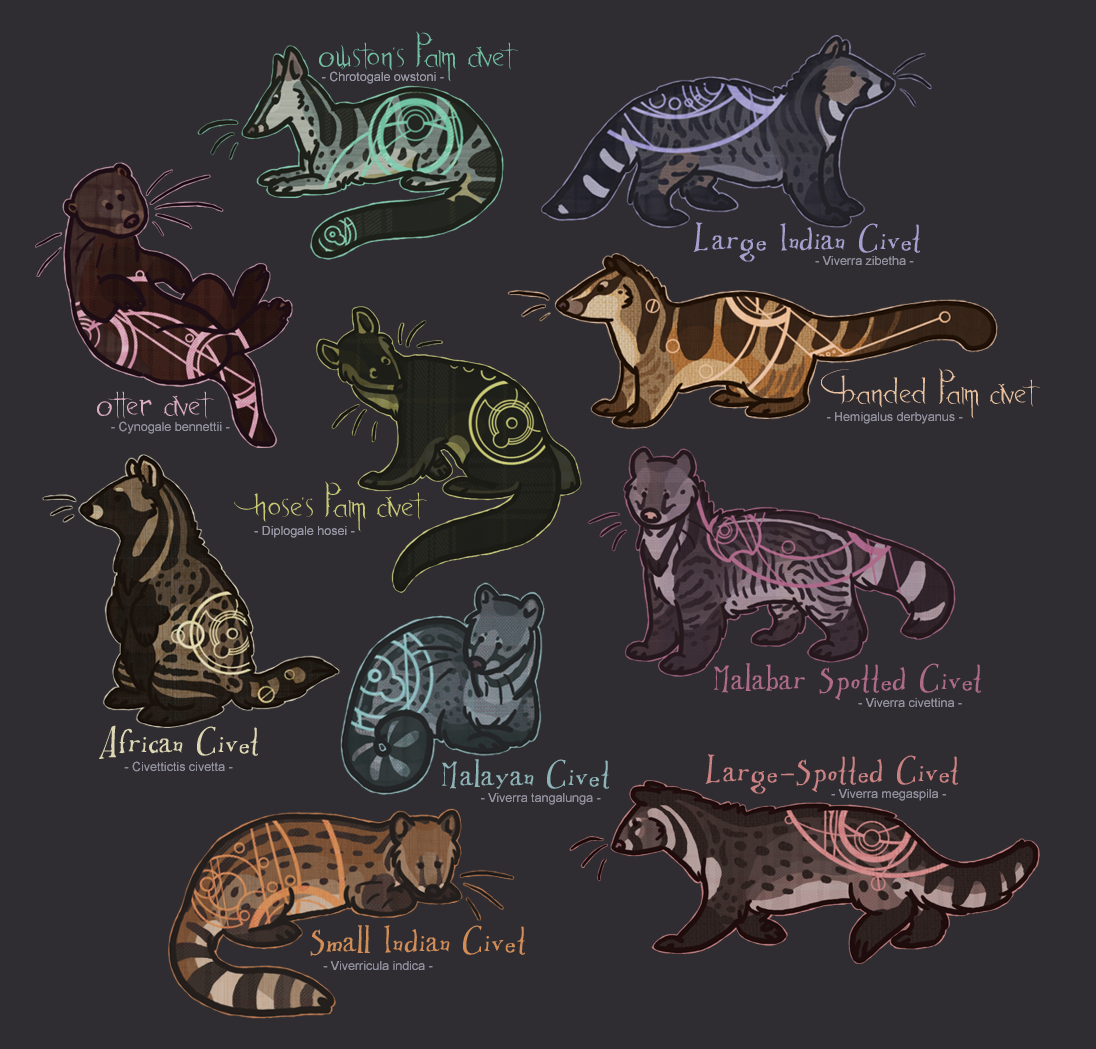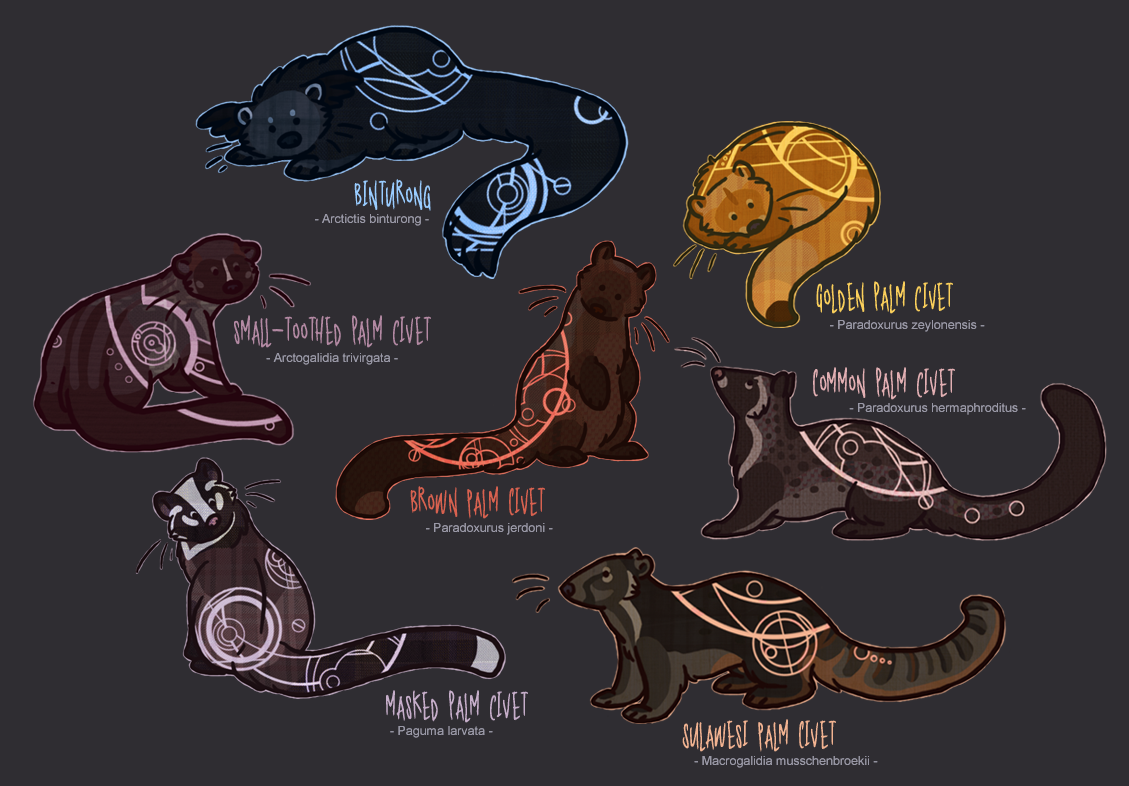A civet is a small, lithe-bodied, mostly nocturnal mammal
native to tropical Asia and Africa, especially the tropical forests.
The term civet applies to over a dozen different mammal species. Most of
the species diversity is found in southeast Asia. The best-known civet
species is the African Civet, Civettictis civetta, which historically has been the main species from which was obtained a musky scent used in perfumery. The word civet may also refer to the distinctive musky scent produced by the animals.
TAXONOMY
The common name is used for a variety of carnivorous mammalian
species, mostly of the family Viverridae.
The African Palm Civet (Nandinia binotata) is
genetically distinct and belongs in its own monotypic family, Nandiniidae.
Civets are also called "toddycats"
in English and "musang" in Malay.
The latter may lead to some confusion as the indigenous word "musang"
has been appropriated to foxes, which exist in popular culture but are not native and
generally never encountered in that geographical region.
Scientific classification
|
|
Kingdom:
|
|
Phylum:
|
|
Class:
|
|
Order:
|
|
Family:
|
|
Generra
|
|
MY ROLES
Coffee
Kopi Luwak, also known as caphe cut chon (fox-dung
coffee) in Vietnam and kape alamid in the Philippines, is coffee that
is prepared using coffee cherries that have been eaten and partially
digested by the Asian palm civet, then harvested from its fecal
matter. The civets digest the flesh of the coffee cherries but pass the
beans inside, leaving their stomach enzymes to go to work on the beans, which
adds to the coffee's prized aroma and flavor. 1 pound (0.45 kg) can cost
up to $600 in some parts of the world and about $100 a cup in others. A
2012 investigation by the Guardian newspaper found Indonesian civets
held separately in cramped cages. The animals were force-fed a debilitating
diet of coffee cherries in conditions described by the Traffic charity
as "awful" and "horrific". There is a campaign under way to
encourage "ethical civet coffee".
Pets
Some of the indigenous people in Peninsular
Malaysia, the Orang Asli, may occasionally keep pet civets.
Urban Environments
Palm civets often venture into urban and suburban environments,
with people often complaining about civet feces or noise from the animals
climbing on roofs. Some studies have been undertaken to examine and mitigate
human-animal conflict in these cases.
Natural Environments
Civet is a carnivorous animal, and like
other species of civet, it survives on a meat-based diet, supplemented by
the odd plant or fruit. Small animals such as
rodents,lizards, snakes and frogs make up the majority of
the civet's diet, along withinsects and other small creatures
scuttling through the under-growth. Civets are also known to eat the fruits and
flowers of palms, mangos and coffee in their natural habitats.
Despite being a secretive yet relatively
ferocious predatory animal, civet is actually preyed upon by a number
of predators within their natural environment. Large
predatory cats are the most common predators of the Asian
palm civet including tigers and leopards along
with reptiles such as large snakes and crocodiles.
FIND CIVETS!
Viverrids are native to Africa (except the
area immediately south of the Mediterranean), Madagascar, the Iberian
Peninsula, southern China, South and Southeast Asia. Favoured habitats
include woodland, savanna, and mountain biomes and,
above all, tropical rainforest. In consequence, many are
faced with severe loss of habitat; several species are considered vulnerable
and the Otter Civet is classified as endangered. Some species of civet are very
rare and elusive and hardly anything is known about them, e.g., the Hose's Civet, endemic to
the montane forests of northern Borneo, is one of
the world's least known carnivores.


In Sri Lanka,
the Asian palm civet species is known as
"Uguduwa" by the Sinhala speaking community. The
terms Uguduwa and Kalawedda are used interchangeably by the
Sri Lankan community to refer to the same animal. However, the term Kalawedda
is mostly used to refer to another species in the civet family, the Small Indian Civet. Sri Lanka also has an
endemic civet species called Golden
Palm Civet. In Bangladesh and in Bangla speaking areas of India this animal
is known as "Khatash" and is now extremely rare in all parts of
Bangladesh.
APPEARANCE

Civets have a broadly cat-like general appearance, though the muzzle is extended and often pointed, rather like that of an otter or a mongoose.
They range in length from about 17 to 28 in (43 to 71 cm) (excluding
their long tails) and in weight from about 3 to 10 lb (1.4 to 4.5 kg).
The civet produces a musk (also
called civet) highly valued as a fragrance and stabilizing agent for
perfume. Both male and female civets produce the strong-smelling
secretion, which is produced by the civet's perineal glands.
It is harvested by either killing the animal and removing the glands,
or by scraping the secretions from the glands of a live animal. The
latter is the preferred method today.
Animal rights groups, such as the World Society for the Protection of Animals, express concern that harvesting musk is cruel to animals. Between these ethical concerns and the availability of synthetic substitutes, the practice of raising civets for musk is dying out. Chanel, maker of the popular perfume Chanel No. 5, claims that natural civet has been replaced with a synthetic substitute since 1998.
Animal rights groups, such as the World Society for the Protection of Animals, express concern that harvesting musk is cruel to animals. Between these ethical concerns and the availability of synthetic substitutes, the practice of raising civets for musk is dying out. Chanel, maker of the popular perfume Chanel No. 5, claims that natural civet has been replaced with a synthetic substitute since 1998.
The World’s Most Expensive Coffee Is a Cruel Cynical Scam
For the most part, civet coffee is not harvested in the wild in limited
quantities but mass produced by animals kept in appalling conditions —
it's high time we stopped drinking it
The costliest coffee on earth has a humble proletarian beginning. As folklore has it, civet coffee, or kopi luwak in Indonesian, was discovered by plantation workers in colonized Indonesia. Forbidden from consuming coffee beans picked from the plants, they picked up, cleaned and then roasted the beans excreted by wild Asian palm civets that entered the plantations to eat the ripest coffee cherries. The civets’ digestive systems gave kopi luwak a uniquely rich aroma and smooth, rounded flavor — so much so that the Dutch plantation owners soon became die-hard fans.
In the past 10 years, kopi luwak has won the hearts — and wallets — of global consumers. A cup sells for $30 to $100 in New York City and London, while 1 kg of roasted beans can fetch as much as $130 in Indonesia and five times more overseas. The ultimate in caffeine bling is civet coffee packed in a Britannia-silver and 24-carat gold-plated bag, sold at the British department store Harrods for over $10,000. The justification for these exorbitant prices? A claim that kopi luwak is sourced from wild animals and that only 500 kg of it is collected annually. The claim is largely nonsense.
While there are some ethical suppliers of hand-gathered civet coffee, recent investigations, both by journalists and animal-rights activists, have revealed a cruel and avaricious industry. To satisfy global demand, many suppliers keep captured civets in cages and feed them almost exclusively on coffee cherries. Enduring appalling living conditions and an unhealthy diet, these nocturnal omnivores suffer mental distress — incessantly pacing and gnawing on their limbs — and succumb to illness and death. These grim farms are not confined to Indonesia. Farmers elsewhere in Asia have jumped on the bandwagon. By one estimate, 50 tons of mass-produced civet coffee from Indonesia, Vietnam, the Philippines and China flood the market every year.
One of the most outspoken critics is former coffee trader Tony Wild, who imported a single kilogram of kopi luwak to the U.K. in 1991 and took pride in introducing it to the Western world. (The coffee gained wider notoriety after being featured in The Oprah Winfrey Show in 2003 and the myth of its all-natural origins was propagated in a Jack Nicholson–Morgan Freeman scene in the 2007 film The Bucket List.) Wild, who witnessed horrific animal abuse while helping a BBC team investigate civet-coffee farms in Sumatra, has launched a petition and social-media campaign, “Kopi Luwak: Cut the Crap,” urging customers and companies to shun the product.
“The coffee trade has conspired to turn a blind eye to the wildlife suffering in order to get this business going,” says Wild, who is also the author of Coffee: A Dark History. “It is a bit of a racket.”
Teguh Pribadi, founder of the Indonesian Civet Coffee Association, admits animal cruelty is rampant in the industry. “The luwaks aren’t treated well,” he tells TIME. “Many farmers don’t understand how to keep the animals properly.” The association recommends the civets be kept in cages that are at least 2 m by 1½ m wide and 2½ m high, and for no longer than six months.
“We tell farmers to focus on the quality, not the quantity of the product,” Teguh says. “It’s better if they produce little but superior coffee, and don’t have dying civets.”
Yet animal experts say Asian palm civets — solitary and territorial by nature — shouldn’t be kept in cages, nor in enclosures, because a single civet needs an average of 17 sq km of territory. “I have seen 100 luwaks kept in a half-hectare coffee farm,” Wild says. “It’s kind of a prison camp where they fight each other.”
Besides, the harvesting of genuine kopi luwak, gathered in the wild, seems either more trouble than its worth — or hazardous to health. “We don’t know how long a dropping has been out in the wild,” Teguh says, “and civet-coffee beans that have been on the ground for more than 24 hours can be infected with fungi.” Wild has been told by a local expert that “following a luwak around all night yourself” is the only way to guarantee real kopi luwak — and, now it seems, a fungi-free drink too. Maybe we’re better off sticking to a cup of regular arabica.
SOURCE: WORLD.TIME.COM
The costliest coffee on earth has a humble proletarian beginning. As folklore has it, civet coffee, or kopi luwak in Indonesian, was discovered by plantation workers in colonized Indonesia. Forbidden from consuming coffee beans picked from the plants, they picked up, cleaned and then roasted the beans excreted by wild Asian palm civets that entered the plantations to eat the ripest coffee cherries. The civets’ digestive systems gave kopi luwak a uniquely rich aroma and smooth, rounded flavor — so much so that the Dutch plantation owners soon became die-hard fans.
In the past 10 years, kopi luwak has won the hearts — and wallets — of global consumers. A cup sells for $30 to $100 in New York City and London, while 1 kg of roasted beans can fetch as much as $130 in Indonesia and five times more overseas. The ultimate in caffeine bling is civet coffee packed in a Britannia-silver and 24-carat gold-plated bag, sold at the British department store Harrods for over $10,000. The justification for these exorbitant prices? A claim that kopi luwak is sourced from wild animals and that only 500 kg of it is collected annually. The claim is largely nonsense.
While there are some ethical suppliers of hand-gathered civet coffee, recent investigations, both by journalists and animal-rights activists, have revealed a cruel and avaricious industry. To satisfy global demand, many suppliers keep captured civets in cages and feed them almost exclusively on coffee cherries. Enduring appalling living conditions and an unhealthy diet, these nocturnal omnivores suffer mental distress — incessantly pacing and gnawing on their limbs — and succumb to illness and death. These grim farms are not confined to Indonesia. Farmers elsewhere in Asia have jumped on the bandwagon. By one estimate, 50 tons of mass-produced civet coffee from Indonesia, Vietnam, the Philippines and China flood the market every year.
One of the most outspoken critics is former coffee trader Tony Wild, who imported a single kilogram of kopi luwak to the U.K. in 1991 and took pride in introducing it to the Western world. (The coffee gained wider notoriety after being featured in The Oprah Winfrey Show in 2003 and the myth of its all-natural origins was propagated in a Jack Nicholson–Morgan Freeman scene in the 2007 film The Bucket List.) Wild, who witnessed horrific animal abuse while helping a BBC team investigate civet-coffee farms in Sumatra, has launched a petition and social-media campaign, “Kopi Luwak: Cut the Crap,” urging customers and companies to shun the product.
“The coffee trade has conspired to turn a blind eye to the wildlife suffering in order to get this business going,” says Wild, who is also the author of Coffee: A Dark History. “It is a bit of a racket.”
Teguh Pribadi, founder of the Indonesian Civet Coffee Association, admits animal cruelty is rampant in the industry. “The luwaks aren’t treated well,” he tells TIME. “Many farmers don’t understand how to keep the animals properly.” The association recommends the civets be kept in cages that are at least 2 m by 1½ m wide and 2½ m high, and for no longer than six months.
“We tell farmers to focus on the quality, not the quantity of the product,” Teguh says. “It’s better if they produce little but superior coffee, and don’t have dying civets.”
Yet animal experts say Asian palm civets — solitary and territorial by nature — shouldn’t be kept in cages, nor in enclosures, because a single civet needs an average of 17 sq km of territory. “I have seen 100 luwaks kept in a half-hectare coffee farm,” Wild says. “It’s kind of a prison camp where they fight each other.”
Besides, the harvesting of genuine kopi luwak, gathered in the wild, seems either more trouble than its worth — or hazardous to health. “We don’t know how long a dropping has been out in the wild,” Teguh says, “and civet-coffee beans that have been on the ground for more than 24 hours can be infected with fungi.” Wild has been told by a local expert that “following a luwak around all night yourself” is the only way to guarantee real kopi luwak — and, now it seems, a fungi-free drink too. Maybe we’re better off sticking to a cup of regular arabica.
SOURCE: WORLD.TIME.COM
Langganan:
Postingan (Atom)





